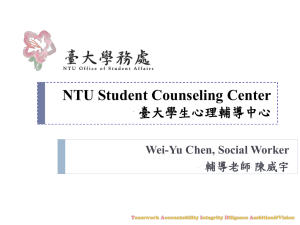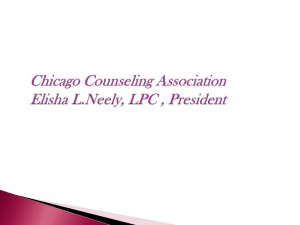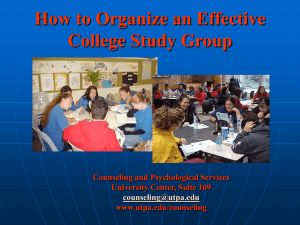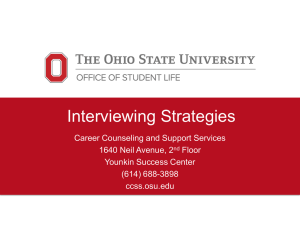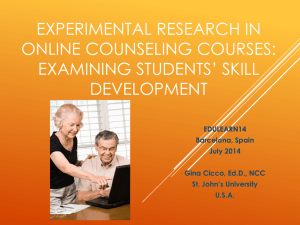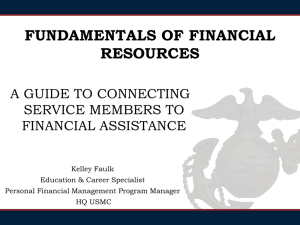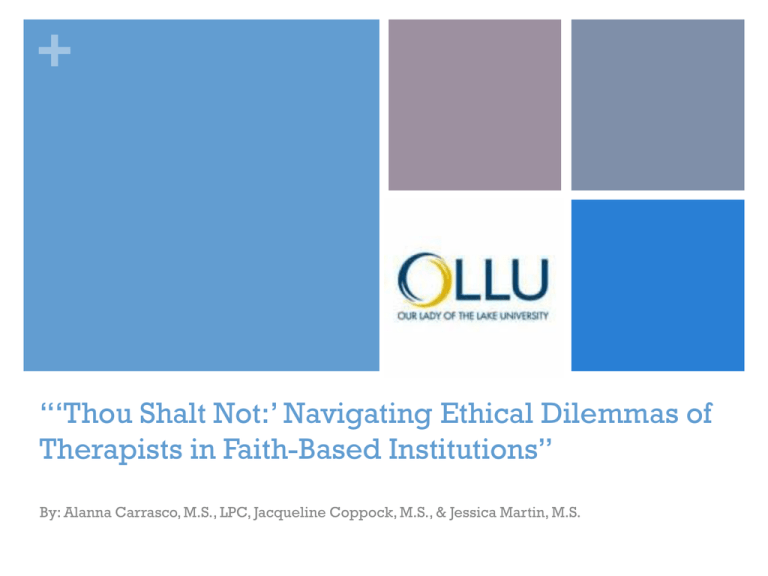
+
“‘Thou Shalt Not:’ Navigating Ethical Dilemmas of
Therapists in Faith-Based Institutions”
By: Alanna Carrasco, M.S., LPC, Jacqueline Coppock, M.S., & Jessica Martin, M.S.
+
2
Goals
To review current literature, outreach, consultation, and treatment
methods used by therapists at small and/or faith-based institutions that
may/may not be effective in reach minority populations.
To facilitate conversations and awareness of ethical dilemmas faced by
university counseling therapist in providing effective mental health
interventions for minority students (i.e., ethnicity and sexuality) at small
and/or faith-based institutions.
To exchange ideas and enhance perspectives on ethically sound
methods to meet the mental health needs of diversify
college/university populations.
+
3
Learning Objectives
At the end of the session attendees will be able to :
Discuss the unique difficulties of university therapists at small and/or
faith based institutions.
Describe and analyze ethical dilemmas regarding outreach,
consultation, and counseling services provided to minority groups at
small and/or faith-based institutions.
Practice case formulation and provide suggestions for developing
interventions tailored to minority populations at small and/or faithbased institutions.
+ Mental Health Needs of University
Students
Approximately 1.8 million students who are enrolled in U.S.
colleges seek help from their campus counseling centers
each year (American College Health Association, 2008).
Administrators from an array of ten universities reported
that the severity of mental health concerns on campus has
increased (Watkins, Hunt, & Eisenberg, 2011).
77% of counseling center directors who responded to the
annual survey of the Association of University Counseling
Center Directors report believing that the number of
students with severe psychological problems on their
campuses has increased. (Barr, Rando, Krylowicz & Reetz,
2010).
91% of respondents to the annual National Survey of
Counseling Center Directors affirm a trend toward a
greater number of students with severe psychological
problems on campus (Gallagher, 2010).
4
5
+ Dominant Mental Health Concerns
The Center for Collegiate Mental Health (2012), reports that about ½ of
students who use counseling are new to mental and behavioral health
services, but about 1/3 of them have ongoing issues.
Data from the 2013 National College Health Assessment II indicate:
1/3 students across the U.S. experienced depression
½ students experienced overwhelming anxiety over the past year
20% had seriously considered suicide
5.8% attempted suicide
Commonly cited mental health concerns
Stress
Depression
Anxiety
Eating Disorders
Substance Use
Relationship Concerns
6
7
Stress
Relationship
Difficulties
Increased
Alcohol Use
Difficulties
with
Coursework
Depression
+
Mental Health Crises
73% of students stated they experienced a mental health crisis
while in college.
These students site the following as the top “triggers”
Extreme feelings of anxiety, panic, and/or depression about school
and life
Difficulty adjusting to a new routine and environment
Feelings of homesickness, loneliness, and isolation.
Stressed or overwhelmed about course load.
PTSD episode triggered by class content.
8
The Changing Face of
University Students
•
•
•
•
In Fall of 2014, 21 million
students attended
Colleges in the U.S.
Females account for the
majority of college
students.
+
Traditional age college
students continue to be
the dominant population
attending U.S.
universities.
The percentage of ethnic
minority college
students continues to
increase.
9
+
10
Level of
institution
Sex
Race/ethnicity
American
Indian/ Two or
Total, all
Pacific
Alaska
more
Year students 2-year 4-year Male Female White Black Hispanic Asian Islander Native
races
2010
41.2
12.9
28.2
38.3
44.1
43.3
38.4
31.9
63.6
36.0
41.4
38.3
2011
42.0
12.0
30.0
39.1
44.9
44.7
37.1
34.8
60.1
37.8
23.5
38.8
2012
41.0
12.7
28.3
37.6
44.5
42.1
36.4
37.5
59.8
50.3
27.8
39.4
SOURCE: U.S. Department of Commerce, Census Bureau, Current Population Survey (CPS), October, 1967
through 2012. (This table was prepared May 2013.)
+
11
University Students with
Minority Identities
Despite experiencing increased discrimination, marginalization,
and oppression,
Ethnic minority students are less likely to utilize counseling services than
their white counterparts (Davidson, Yakushka, & Sanford-Martens, 2004;
Kearney, Draper, Baron, 2005).
Hayes et al. (2011).
LGBT students, though reporting a higher perceived need for counseling
services, reported significantly less utilization of services than their
heterosexual counterparts (Eisenberg, Golberstein, Gollust, 2007).
+
12
Accredited college counseling
services must provide:
Individual & group counseling
Testing & other assessments
Outreach efforts
Support on correcting certain educational deficiencies
Crisis intervention & emergency coverage
Professional development programs for faculty & staff
Programming focused on the developmental needs of students
Consultative services to members of university community
Research and evaluation of services
(Council for Advancement of Standards in Higher Education, 1997)
(IACS; Kiracofe et al., 1994)
+ CURRENT OUTREACH, CONSULTATION,
TREATMENT INTERVENTIONS FOR SMALL
CAMPUSES
Small college/university – 5,000 students or less (Richardson,1985)
Small counseling staff – staffed by less than 3 full-time counselors
(Thomas,2000)
13
+ CURRENT OUTREACH, CONSULTATION,
TREATMENT INTERVENTIONS FOR SMALL
CAMPUSES
Personal counseling
Career testing and exploration
Academic advising
Public and campus outreach
Consultation services for campus community
Crisis intervention
Disability services
Drug and alcohol awareness programs
National testing services
Manage employee assistance programs
Direct peer educator and residence life training
(Thomas, 2000)
14
+ CURRENT OUTREACH, CONSULTATION,
TREATMENT INTERVENTIONS FOR SMALL
CAMPUSES
Due to confines of maintaining confidentiality on a small campus,
interpersonal processing groups may be limited
Staff therapists at small campuses may be more likely to utilize:
Structured psychoeducational groups
Workshops for campus groups, residence hall meetings, guest lectures
(Thomas, 2000)
15
+
16
CURRENT OUTREACH, CONSULTATION,
TREATMENT INTERVENTIONS FOR SMALL
CAMPUSES
Additional “non-traditional” responsibilities that many times lead
to dual-relationships (Thomas, 2000)
Chair committees
Teach courses
Academic advising
Campus social functions
Additional responsibilities/interventions toward minority
populations (Brinson & Kottler, 1995)
Special interest group workshops
Minority mentoring programs
Consultation/outreach to minority student programs
Hosting “drop-in” services
+
17
Faith-Based Institutions
“Seeds of faith are always within us; sometimes it takes
a crisis to nourish and encourage their growth” –
Unknown
Beginning the journey and choosing a faith-based
college/university.
Intellectual challenge, spiritual growth, and leadership
development
Examining a different set of qualities – types of faith
that shape educational programs, the activities or
services offered for students
Public University vs. Faith-Based
+
18
Faith-Based Institutions
Spiritual Growth
College is a period of personal and professional growth.
Values and Ethics
Moral Principles
Respect for Persons
+ Religiously-affiliated universities in the
“Top Colleges in Texas”
(American School Search, 2015)
Baylor University (Baptist)
Trinity University (Presbyterian)
Southern Methodist University
(Methodist)
St. Edward’s University (Roman
Catholic)
Texas Christian University
(Christian Church Disciples of Christ)
Texas Wesleyan University (United
Methodist)
Abilene Christian University
(Christian Churches & Churches of Christ)
University of St. Thomas (Roman
Catholic)
Dallas Baptist University (Baptist)
University of the Incarnate Word
(Roman Catholic)
Our Lady of the Lake University
(Roman Catholic)
University of Dallas (Roman
Catholic)
St. Mary’s University (Roman
Catholic)
19
+ RELIGIOUS/FAITH-BASED
ASSOCIATIONS THAT INFLUENCE
STUDENT AFFAIRS
Association of Catholic Colleges & Universities (ACCU)
Counseling for Christian Colleges & Universities (CCCU)
National Association of Schools & Colleges of the United Methodist
Church (NASCUMC)
Association for Christians in Student Development (ACSD)
20
+ Association of Catholic Colleges &
21
Universities (ACCU)
“Good practice for student affairs at Catholic colleges and
universities”
Principle 1
Principle 2
Grounds policies, practices, and decision in the teachings and living
tradition of the Church. Builds and prepares the student affairs staff to make
informed contributions to the Catholic mission of the institution.
Principle 3
Welcomes all students into a vibrant campus community that celebrates
God’s love for all
Enriches student integration of faith and reason through the provision of cocurricular learning opportunities.
Principle 4
Creates opportunities for students to experience, reflect upon, and act from
a commitment to justice, mercy, and compassion, and in light of Catholic
social teaching to develop respect and responsibility for all, especially those
most in need.
+ Association of Catholic Colleges &
Universities (ACCU)
Principle 5
Challenges students to high standards of personal behavior
and responsibility through the formation of character and
virtues.
Principle 6
Invites and accompanies students into the life of the
Catholic Church through prayer, liturgy, sacraments, and
spiritual direction.
Principle 7
Seeks dialogue among religious traditions and with
contemporary culture to clarify beliefs and to foster mutual
understanding in the midst of tensions and ambiguities.
http://www.accunet.org/files/public/~ACCU%20Members%20List%281%29.pdf
22
+ Counseling for Christian Colleges &
23
Universities (CCCU)
“A member institution meets five requirements”:
1) It is a nonprofit, North American institution with non-probationary
regional accreditation (or the Canadian equivalent) that offers
comprehensive undergraduate curricula rooted in the arts and sciences;
2) It has a Christian mission statement and integrates Biblical faith into
its educational programs;
+ Counseling for Christian Colleges &
Universities (CCCU)
3) It has an institutional policy and practice to hire only persons who
profess faith in Jesus Christ as full-time faculty members and
administrators;
4) It is committed to advancing the cause of Christian higher education
and is supportive of other Christian colleges and universities; and
5) It operates under the standards of the Evangelical Council for
Financial Accountability.
http://www.cccu.org/members_and_affiliates
24
+ National Association of Schools &
Colleges of the United Methodist Church
(NASCUMC)
“NASCUMC is a voluntary association of schools, colleges, and
universities committed to the historic and distinctive values of
United Methodist-related education. It exists”:
To advance the work of education and scholarship in member
institutions,
To work cooperatively with conferences, boards and agencies of The
United Methodist Church to address issues of mutual concern to the
Church and the Academy,
25
+ National Association of Schools &
Colleges of the United Methodist Church
(NASCUMC)
To work in partnership with the Church to educate students for
leadership and service to the global community,
To foster and encourage the common good of member institutions, and
To strengthen the collegiality and camaraderie among member
presidents, deans and heads of school.
http://www.gbhem.org/sites/default/files/documents/education/SCU_UMRELATEDSCU.PDF
26
+ Association for Christians in Student
Development (ACSD)
“The
mission of the Association for Christians in
Student Development is to equip and challenge
members to infuse their Christian faith into
student development practice and scholarship.”
Values:
Faith-fullness: We embrace the dynamic interplay of Biblical truth,
wisdom and Christian faith as the foundation for professional and
spiritual growth in Student Affairs.
Learning: We aspire to be a culture of reflection and curiosity that
informs scholarship and practice.
Excellence: We strive to create a quality and distinction in what we say
and do within the field of Student Affairs.
27
+
28
Association for Christians in
Student Development (ACSD)
Innovation: We
seek to be analytical, quantitative,
creative, and collaborative in discovering new and
alternate ways of knowing and practice.
Inclusivity: We desire to be a Christ-centered and
unified community that engages effectively in difficult
dialogue and fosters respect for cultural differences.
Relationships: We value participating and investing in a
supportive, challenging, and purposeful community.
http://www.acsd.org/about-us/mission-statement/purpose/
+ RESPONSIBILITY OF UNIVERSITY
THERAPIST TO INSTITUTIONAL
REQUIREMENTS
Most university/college mental health services are housed under
Student Affairs
Religious-affiliated institutions may have strict guidelines of the
values and standards to be held by student affairs staff
The university therapist faces the dilemma of how to respond to
these institutional requirements
29
+
30
Value conflicts within faithbased institutions
College and university counseling centers function in an environment
that has frequently changed since such services were first developed.
Sexual orientation and gender identity
Counseling issues related to termination of pregnancies
Sexual relations outside of marriage
Counseling individuals from cultural or racial backgrounds different
from that of the counseling.
Substance Use
Suicide
+
31
Ethical Dilemmas – APA Code
of Ethics
Principle A: Beneficence and
Nonmaleficence
Principle B: Fidelity and Responsibility
Principle C: Integrity
Principle D: Justice
Principle E: Respect for People’s Right and
Dignity
+
32
Ethical Dilemmas – Teased
Apart
First, the code of ethics of the American Psychological Association
(APA,2002) indicates that the promise of confidentiality is not an
unqualified one. Standard 4.01 (Maintaining Confidentiality) states
that
Psychologist have a primary obligation and [must] take reasonable
precautions to protect confidentiality information obtained through or
store in any medium, recognizing that the extent and limits of
confidentiality may be regulated by law or established by institutional rules
or professional or scientific relationships (APA, 2002, p. 1066)
+
33
Ethical Dilemmas - ACA
The ACA Code of Ethics (American Counseling Association [ACA],
2005) makes a similar statement in acknowledging that counseling
personnel may have other institutional roles. According to Standard
D.1.d (Confidentiality),
when counselors are required by law, institutional policy, or
extraordinary circumstances to serve in more than one role in judicial
or administrative proceedings, they [must] clarify roles expectations
and the parameters of confidentiality with their colleagues (ACA,
2005, p. 11).
Ethical
Responsibilities
of
University
+
Therapists to Student Clients
APA General Principles:
Beneficence and
Nonmaleficence
Fidelity and Responsibility
Integrity
Justice
Respect for People’s Rights
and Dignity
APA Ethical Standards:
Resolving Ethical Issues
Competence
Human Relations
Privacy and Confidentiality
Advertising and Other
Public Statements
Record Keeping and Fees
Education and Training
Research and Publication
Assessment
Therapy
34
Areas of Growth Regarding Our
Ethical Responsibilities to Students
35
• 64% of students who are no longer attending college stated
they dropped out because of mental health related concerns
• Students cited “fear or concern for the impact of disclosing
would have on how students, faculty, and staff perceive them” as
the number one reason not to disclose their mental health
condition.
• Additionally, students rated stigma as the number one
barrier to accessing mental health services and support.
• Students believe there are not enough adequately trained
mental health providers.
• Students disclosed they would like for there to be more
communication between mental health providers and others
involved in their care.
+
36
The chicken or the egg?
At
some point during their college
experience, students may encounter
personal, social, career or academic issues
that call for assistances beyond the advice
provided by friends and family
Seeking
individual counseling and therapy
Group counseling and therapy
Outreach programs (i.e., eating or bullying awareness)
Interpersonal Violence Prevention
+
37
Consultation
University
Counseling Center staff members are
available to consult with students, faculty and
staff on a broad range of issues. Common topics
include resolving conflicts with roommates,
classmates, coworkers and supervisors;
managing crisis situations in the classroom or
residence hall; and coping with emotionally
distraught students, friends or family.
+
38
Outreach Services
The
University Counseling Center provides outreach
services to the campus community. These programs are
specifically designed to address unique or other salient
campus situations or concerns, such as eating disorders,
study problems, stress relief, grieving and more, through
workshops, training, flyers, and programming. These
services are preventative and seek to teach the campus
community coping skills, recognition of warning signs,
communication skills, and more to help promote healthy
mental and emotional well-being.
+
39
Vignette – The Case of Liz
Liz is a 19-year-old White female in her sophomore year. She is a
transfer student who completed her first year at a community college
near home. She transferred to a local Christian University to finish her
undergraduate degree in Economics. She was referred to the
university counseling center by the residence hall director because
she appeared to be unhappy and distraught living in the residence
hall. Liz is typically described as an “outgoing” and “brilliant” girl, who
makes friends easily. During the initial session, Liz expressed that she
recently lost her virginity to guy she met at an off-campus party and
contracted a VD. This event has caused her to feel shame and guilt,
since premarital intercourse is strictly prohibited within her faith. She
is also concerned that her parents may “disown” her and refuse to
continue paying for her education. Additionally, Liz was recently
placed on academic probation and is in jeopardy of losing all
university benefits (i.e., housing, partial financial aid, and being
removed from tennis team).
+
40
Vignette – The Case of Callie
Callie, a 21 year old Philippine female is in her third year of college
at a Catholic university. She reports being actively involved in the
University Newman Center and photography club. Lately, Callie has
found herself attracted to a female friend, though she has not acted
on her feelings due to religious beliefs and family disapproval of
homosexuality. Recently, Callie celebrated a friend’s birthday at a
lesbian bar. As she left the bar and was walking to her vehicle, a
group of male students driving by pulled over shouting out “Lezzie!
Come here, I’ll show you what you need in your life.” Thankfully,
some other bar patrons were passing by and safely escorted her
the remaining way to her car. Callie enters counseling two weeks
after this incident complaining of difficulty sleep, disturbing
memories, sadness, and anxiety.
+
41
Vignette – The Case of Daniel &
his advisor
Daniel is an 18 year-old male, first generation college student, at a
small, Catholic university. Daniel is an officer in the Student
Government Association. Recently he has opened up to his fellow
officers and student organization advisor, Mr. Schmidt, that he has
been questioning his sexuality and struggling with loss of sleep,
appetite, and tearfulness. His comrades refer him for on campus
counseling. You are his therapist and run into Mr. Schmidt at a
Student Affairs meeting. In an informal consultation with Mr.
Schmidt, he says that he values being connected with the SGA
officers and asks you for any information regarding Daniel’s case
that might enable him to be helpful. How do you respond knowing
that Mr. Schmidt is a proponent of the counseling center and
frequently refers students, yet also work in Daniel’s best interest?
+
42
References
Brinson, J.A., & Kottler, J.A. (1995). Minorities' underutilization of counseling centers' mental
health services: A case for outreach and consultation. Journal of Mental Health Counseling,
17(4), 371.
Council for the Advancement of Standards in Higher Education. (1997). The CAS book of
professional standards for higher education. Washington, D.C.: Author.
Estanek, S.M. & James, M.J. (2010). Principles of good practice for student affairs at Catholic
colleges and universities. Retrieved from Association of Catholic Colleges and Universities
website: http://www.accunet.org/files/public/REV4PrinciplesofGoodPractice.pdf
Kiracofe, N.M., Donn, P.A., Grant, C.O., Podolnick, E.E., Bingham, R.P., Bolland, H.R., Carney,
C.G., Clementson, J., Gallagher, R.P., Grosz, R.D., Handy, L., Hansche, J.H., Mack, J.K., Sanz, D.,
Walker, L.J., & Yamada, K.T. (1994). Accreditation standards for university and college
counseling centers. Journal of Counseling and Development, 73, 38-43.
Locations of Schools, Colleges, and Universities of The United Methodist Church, U.S.A. (2014).
In General Board of Higher Education and Ministry. Retrieved January 20, 2015 from
http://www.gbhem.org/sites/default/files/documents/education/SCU_UMRELATEDSCU.PDF
+
43
References (cont.)
Members and Affiliates. (2015). In Council for Christian Colleges and Universities. Retrieved January
20, 2015 from http://www.cccu.org/members_and_affiliates
Purpose. (2015). In Association for Christians in Student Development. Retrieved January 20, 2015 from
http://www.acsd.org/about-us/mission-statement/purpose/
Richardson, B.K. (1985). Delivery of counseling and psychological services in small colleges: A
national study. Journal of College Student Personnel, 26(6), 508-512.
Thomas, J.R. (2000). Strategies for small staff college counseling centers. In D.C. Davis & K.M.
Humphrey (Eds.) College Counseling: Issues and Strategies for a New Millennium. Alexandria, VA:
American Counseling Association.
+
44
References
American College Health Association. (2008). American College Health Association—National
College Health Assessment spring 2007 reference group data report. Journal of American College
Health, 56, 469–488.
Blanco, C., Okuda, M., Wright, C., Hasin, D. S., Grant, B. F., Liu, S., & Olfson, M. (2008). Mental health
of college students and their non-college-attending peers: Results from the National
Epidemiologic Study on Alcohol and Related Conditions. Archives of General Psychiatry,65, 1429–
1437.
Barr V, Rando R, Krylowicz B, Reetz D. Association for University and College Counseling Center
Directors annual survey. 2010. http://aucccd.org/img/pdfs/aucccd directors survey monograph
2010.pdf
Davidson, M. M., Yakushka, O. F., & Sanford-Martens, T. C. (2004). Racial and ethnic minority
clients’ utilization of a university counseling center: An archival study. Journal of Multicultural
Counseling and Development, 32, 259–271.
Douce, L. A., Keeling, R. P., American Council on Education., National Association of Student
Personnel Administrators (U.S.), & American Psychological Association. (2014).A Strategic Primer
on College Student Mental Health.
Eisenberg, D., Golberstein, E., & Gollust, S. E. (2007). Help-seeking and access to mental health
care in a university student population. Medical Care, 45, 7, 594-601.
+
45
References
Fisher, B., Cullen, F. T., Turner, M. G., & National Institute of Justice (U.S.). (2000). The sexual
victimization of college women. Washington, DC: U.S. Dept. of Justice, Office of Justice Programs,
National Institute of Justice.
Gallagher RP. National survey of counseling center directors, 2010. Alexandria, VA: International
Association of Counseling Services, 2010. http://www.iacsinc.org/NSCCD%202010.pdf
Hayes, J. A., Chun-Kennedy, C., Edens, A., & Locke, B. D. (2011). Do double minority students face
double jeopardy? Testing minority stress theory. Journal of College Counseling, 14, 117–126.
Hayes, J. A., Youn, S. J., Castonguay, L. G., Locke, B. D., McAleavey, A. A., & Nordberg, S. (2011).
Rates and Predictors of Counseling Center Use Among College Students of Color. Journal of
College Counseling, 14, 2, 105-116.
Kearney, L. K., Draper, M., & Baron, A. (2005). Counseling Utilization by Ethnic Minority College
Students. Cultural Diversity & Ethnic Minority Psychology, 11, 3, 272-285.
Maramba, G. G., & Hall, G. C. N. (2002). Meta-analysis of ethnic match as a predictor of dropout,
utilization, and level of functioning. Cultural Diversity & Ethnic Minority Psychology, 8, 290–297.
Watkins, D. C., Hunt, J. B., & Eisenberg, D. Increased demand for mental health services on college
campuses: Perspectives from administrators.Qualitative Social Work, 11, 3, 319-337.

